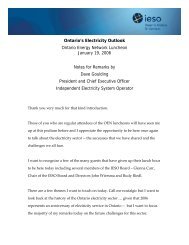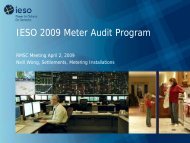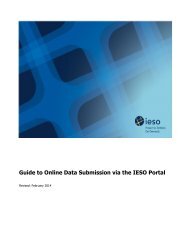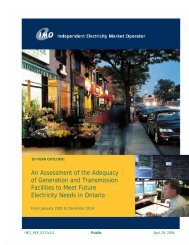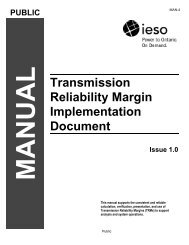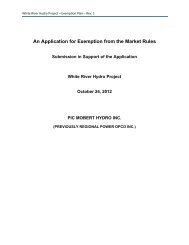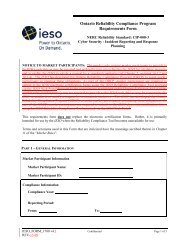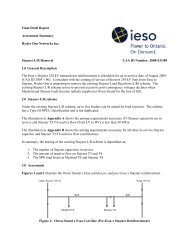Participant Technical Reference Manual - IESO
Participant Technical Reference Manual - IESO
Participant Technical Reference Manual - IESO
You also want an ePaper? Increase the reach of your titles
YUMPU automatically turns print PDFs into web optimized ePapers that Google loves.
3.Dispatch Information<br />
IMO_MAN_0024<br />
c. A Web Client providing user interface for the WEB-Based Message Exchange java applet.<br />
The software as shown on the “<strong>IESO</strong> Supported Client Platform” web page is required in<br />
order to execute the Message Exchange Applet.<br />
d. The ME Database Server is responsible for storing and retrieving the messages and their<br />
status. This database will support both WEB & ICCP.<br />
e. The ME Application Server will co-ordinate the message exchange between different<br />
functions. It is responsible for message scheduling and tracking (both WEB and ICCP).<br />
3.2.3 Dispatch Messaging<br />
206 The dispatch messages are generated automatically by the dispatch algorithm<br />
every five minutes. The Exchange Coordinator (EC) monitors the dispatches<br />
and the EC can prevent the messages from being sent out in the event of a<br />
system disturbance while activating operating reserve.<br />
207 The availability and reliability of the supporting facilities must be such that the<br />
following criteria is met:<br />
a. The Exchange Coordinator (<strong>IESO</strong> BES Control Room Operator), in not more than sixty<br />
seconds after issuance of the dispatch message, must receive the acknowledgement and<br />
compliance indication after issuance of the dispatch instruction.<br />
b. The acknowledgement of receipt of a dispatch message is automatically performed by the<br />
Client application (either <strong>IESO</strong> provided or market participant). The compliance is a<br />
manual action by the market participant to accept or reject the instruction.<br />
c. The <strong>IESO</strong> shall manage and/or control the ICCP and Web-Based communications facilities<br />
that support the transmission of dispatch instructions to the market participants’ dispatch<br />
agent at the point of system injection.<br />
d. Failure of any of the facilities such that the dispatch message and/or the reply are not<br />
sent/received is alarmed through monitoring software to the Exchange Coordinator upon<br />
detection. The alarm is displayed within the message dispatch tool and it will be logged in<br />
the systems control log. The alarm indicates the actual, or most likely, reason for the failure.<br />
e. An outage to any of the supporting message dispatch facilities must be addressed with the<br />
highest priority.<br />
Dispatches Processed Through Message Exchange<br />
Energy Dispatch<br />
208 The <strong>IESO</strong> issues dispatch instructions for each registered facility, other than a<br />
boundary entity and an hour-ahead dispatchable load facility, prior to each<br />
dispatch interval, indicating for that dispatch interval:<br />
• The target energy level to be achieved (in MW) by the facility at the end of the dispatch interval<br />
at a rate, in the case of a dispatchable load, equal to the rate provided by the market participant<br />
as dispatch data, and in the case of a generation facility equal to the most limiting of:<br />
• The last dispatch instruction and offered ramp rate: or<br />
• Actual MW output and the generations facility’s effective ramp rate<br />
Reserve Dispatch<br />
60 Public Issue 21.1 – March 15, 2010 - estimated




